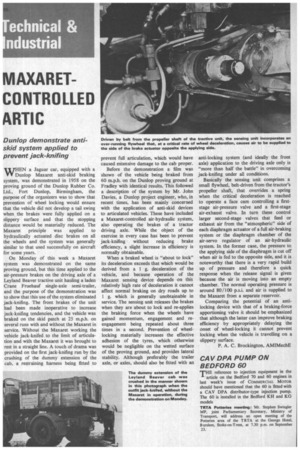MAXARET
Page 100

If you've noticed an error in this article please click here to report it so we can fix it.
CONTROLLED ARTIC
Dunlop demonstrate antiskid system applied to prevent jack-knifing
EN a Jaguar car, equipped with a
Dunlop Maxaret anti-skid braking system, was demonstrated in 1958 on the proving ground of the Dunlop Rubber Co. Ltd., Fort Dunlop, Birmingham, the purpose of the organizers was to show that prevention of wheel locking would ensure that the vehicle did not develop a tail swing when the brakes were fully applied on a slippery surface and that the stopping distance would be materially reduced. The Maxaret principle was applied to hydraulically actuated disc brakes on all the wheels and the system was generally similar to that used successfully on aircraft for some years.
On Monday of this week a Maxaret system was demonstrated on the same proving ground, but this time applied to the air-pressure brakes on the driving axle of a Leyland Beaver tractive unit hauling a laden Crane Fruehauf single-axle semi-trailer, and the purpose of the demonstration was to show that this use of the system eliminated jack-knifing. The front brakes of the unit had been made inoperative to increase jack-knifing tendencies, and the vehicle was braked on the skid patch at 25 m.p.h. on several runs with and without the Maxaret in service. Without the Maxaret working the vehicle jack-knifed to the limit of articulation and with the Maxaret it was brought to rest in a straight line. A touch of drama was provided on the first jack-knifing run by the crushing of the dummy extension of the cab, a restraining harness being fitted to prevent full articulation, which would have caused extensive damage to the cab proper.
Before the demonstration a film was shown of the vehicle being braked from 60 m.p.h. on the Dunlop proving ground at Fradley with identical results. This followed a description of the system by Mr. John Davies, a Dunlop project engineer, who, in recent times, has been mainly concerned with the application of anti-skid devices to articulated vehicles. These have included a Maxaret-controlled air-hydraulic system, also operating the brakes of a tractor driving axle. While the object of the exercise in every case has been to prevent jack-knifing without reducing brake efficiency, a slight increase in efficiency is normally obtainable.
When a braked wheel is "about to lock" its deceleration exceeds that which would be derived from a 1 g. deceleration of the vehicle, and because operation of the Ma/caret sensing device depends on this relatively high rate of deceleration it cannot affect normal braking on dry roads up to I g. which is generally unobtainable in service. The sensing unit releases the brakes when they are about to lock and re-applies the braking force when the wheels have gained momentum, engagement and reengagement being repeated about three times in a second. Prevention of wheellocking materially increases the effective adhesion of the tyres, which otherwise would be negligible on the wetted surface of the proving ground, and provides lateral stability. Although "preferably the trailer axle, or axles, should also be fitted with an
anti-locking system (and ideally the front axle) application to the driving axle only is "more than half the battlein overcoming jack-knifing under all conditions.
Basically the sensing unit comprises a small flywheel, belt-driven from the tractor's propeller shaft, that overrides a spring when the critical deceleration is reached to operate a face cam controlling a firststage air-pressure valve and a first-stage air-exhaust valve. In turn these control larger second-stage valves that feed or exhaust air from the "atmospheric" side of each diaphragm actuator of a full air-braking system or the diaphragm chamber of the air-servo regulator of an air-hydraulic system. In the former case, the pressure to the applying side of the diaphragm is cut off when air is fed to the opposite side, and it is noteworthy that there is a very rapid build up of pressure and therefore a quick response when the release signal is given because the air is moving into an empty chamber. The normal operating pressure is around 80/100 p.s.i. and air is supplied to the Maxaret from a separate reservoir.
Comparing the potential of an antilocking device with that of a braking-force apportioning valve it should be emphasized that although the latter can improve braking efficiency by appropriately delaying the onset of wheel-locking it cannot prevent locking when the vehicle is travelling on a slippery surface.
P. A. C. Brockington, AMIMechE
CAV DPA PUMP ON BEDFORD 60 THE reference to injection equipment in the article on the Bedford 70 and 60 engines in last week's issue of COMMERCIAL Moma should have mentioned that the 60 is fitted with a CAV DPA distributor-type injection pump. The 60 is installed in the Bedford KH and KG models TRTA Potteries meeting: Mr. Stephen Swingler MP. joint Parliamentary Secretary, Ministry of Transport, will address an open meeting of the Potteries area of the TRTA at the George Hotel, Burslem, Stoke-on-Trent, at 7.30 p.m. on September 23.




















































































































































































































































































